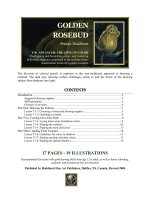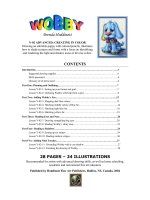Y-01 ADVANCED: CREATING IN COLOR potx
Bạn đang xem bản rút gọn của tài liệu. Xem và tải ngay bản đầy đủ của tài liệu tại đây (1.83 MB, 17 trang )
GOLDEN
ROSEBUD
Brenda Hoddinott
Y-01 ADVANCED: CREATING IN COLOR
Overlapping and burnishing colors, and rendering
believable shadows, contribute to the realistic three-
dimensional forms of a golden rosebud.
The diversity of colored pencils is explored in this non-traditional approach to drawing a
rosebud. The dark gray drawing surface challenges artists to pull the forms of the drawing
subject from darkness into light.
CONTENTS
Introduction……………………………………………………………………………… 3
Suggested drawing supplies…………………………………………………………………3
Skills presented…………………………………………………………………………… 4
Glossary of art terms………………………………………………………………… 4
Part One: Drawing the Outline……………………………………………………………5
Lesson Y1-1: Choosing a format and drawing supplies ……………………………………5
Lesson Y1-2: Outlining a rosebud………………………………………………………… 6
Part Two: Coming Out of the Dark ……………………………………………………….8
Lesson Y1-3: Laying down some foundation colors………………………………… 9
Lesson Y1-4: Shading the rosebud ……………………………………………………… 10
Lesson Y1-5: Shading the stem and leaves ……………………………………………… 13
Part Three: Adding Final Touches……………………………………………………….14
Lesson Y1-6: Guidelines for colors in shadows ………………………………………… 15
Lesson Y1-7: Shading medium and dark values………………………………………… 15
Lesson Y1-8: Shading the darkest shadows……………………………………………… 18
17 PAGES - 19 ILLUSTRATIONS
Recommended for artists with good drawing skills from age 12 to adult, as well as home schooling,
academic and recreational fine art educators
Published by Hoddinott Fine Art Publishers, Halifax, NS, Canada, Revised 2004
Copyright to all articles, images, text, projects, lessons and exercises within this drawing class belong to Brenda Hoddinott and may not
be reproduced or used for any commercial purposes whatsoever without the written permission of Brenda Hoddinott.
Web site or
- 2 -
INTRODUCTION
The diversity of colored pencils is explored in this non-traditional approach to drawing a
rosebud. The dark gray drawing surface challenges artists to pull the forms of the drawing
subject from darkness into light. This lesson is divided into three parts:
PART ONE: setting up your drawing format and drawing a detailed outline
PART TWO: shading light and medium values on the petals, stem, and leaves
PART THREE: adding realistic shadows by mixing a specific recipe of colors.
SUGGESTED DRAWING SUPPLIES
1. Good quality dark drawing paper or mat board
2. White colored pencil
3. Five other colored pencils, as shown in Illustration 1-01.
ILLUSTRATION 1-01
YELLOW ORANGE / RED MEDIUM BLUE PURPLE BLACK
SKILLS PRESENTED
1. Drawing with detailed curved contour lines
2. Adding shading with graduated values
3. Blending colors with burnishing
4. Understanding the theory of color in shadows
GLOSSARY OF ART TERMS
Burnishing: is the application of one layer(s) of color (or white) over another, by pressing hard
with a pencil, to blend colors together. Burnishing of colored pencils can also be done with a
tortillon or a firm plastic eraser.
Color wheel: is a method of arranging colors within a circular format to easily reference colors
and their components such as primary, secondary, and complementary colors.
Complementary colors: are colors which are opposite one another on the color wheel.
Contrast: measures the degree of difference between the light and dark values within
shading, and creates the illusion of three-dimensions in a drawing.
Curved lines: are created when a straight line curves (or bends). Curved lines can be
Copyright to all articles, images, text, projects, lessons and exercises within this drawing class belong to Brenda Hoddinott and may not
be reproduced or used for any commercial purposes whatsoever without the written permission of Brenda Hoddinott.
Web site or
- 3 -
drawn thick or thin.
Drawing: is the application of an art medium to a surface so as to produce an image, which
visually defines an artist’s choice of drawing subjects from his or her own unique perspective.
Drawing space (sometimes called a drawing format): refers to the area of a drawing
surface within a specific perimeter, outlined by a shape of any size, such as a square,
rectangle or circle.
Form: is the illusion of the three-dimensional structure of a shape, such as a circle, square
or triangle, created in a drawing with shading and/or perspective.
Graduated shading (also known as a graduation or graduated values): is a continuous
progression of graduated values from dark to light or from light to dark.
Hatching: is a series of lines (called a set) drawn closely together to give the illusion of
values.
Light source: The direction from which a dominant light originates. The placement of this
light source affects every aspect of a drawing. The light source tells you where to draw all
the light values and shadows.
Outline drawings (also called contour or line drawings): are comprised of lines which
follow the contours of the various components of a drawing subject and define the outlines
of its forms.
Primary colors: are the fundamental colors or pigments of red, yellow, and blue.
Secondary colors: are the pigments or colors, orange, green, and purple created by combining
any two of the primary colors. Red and yellow make orange, yellow and blue make green, and
red and blue make purple.
Shading: refers to the various values that make drawings look three-dimensional.
Shadows: are the areas on an object that receive little or no light.
Shape: refers to the outward outline of a form. Basic shapes include circles, squares and
triangles.
Values: are the different shades of color created when you draw by varying both the
density of the shading lines, and the pressure used in holding your pencils.
PART ONE: DRAWING THE OUTLINE
Throughout this section you place your rosebud within your drawing space and draw a detailed
outline in preparation for adding shading.
LESSON Y1-1: CHOOSING A FORMAT AND DRAWING SUPPLIES
I used a very dark gray drawing paper with a slightly textured surface. You can use any dark
colored drawing paper, but keep in mind that the color of your paper will show through the
colored pencils in some places.
Copyright to all articles, images, text, projects, lessons and exercises within this drawing class belong to Brenda Hoddinott and may not
be reproduced or used for any commercial purposes whatsoever without the written permission of Brenda Hoddinott.
Web site or
- 4 -
Draw a rectangular vertical (sometimes called a portrait format) drawing format. Mine is 3 by 4
inches, but you may choose any size you wish, such as 4.5 by 6 inches, 6 by 8 inches, or 9 by 12
inches. You need only one colored pencil for the first part of this project. Choose a yellow close
in color to Illustration 1-02.
ILLUSTRATION 1-02
LESSON Y1-2: OUTLINING A ROSEBUD
Find a quiet place where you will be uninterrupted for a while, sharpen your yellow pencil and
get ready to draw!
ILLUSTRATION 1-03 ILLUSTRATION 1-04
1. Very lightly draw a simple outline of a rosebud, as in Illustration 1-03.
The rosebud is at an angle within your drawing space, tilted towards the right. Observe the
curve of the stem.
Copyright to all articles, images, text, projects, lessons and exercises within this drawing class belong to Brenda Hoddinott and may not
be reproduced or used for any commercial purposes whatsoever without the written permission of Brenda Hoddinott.
Web site or
- 5 -
2. Pressing a little harder with your yellow pencil, go over your outline.
Refer to Illustration 1-04 and refine the shape of your rosebud by adding a few more details
with curved lines.
ILLUSTRATION 1-05 ILLUSTRATION 1-06
3. As in Illustration 1-05, outline more petals in the center cluster.
4. Add a curved line from the center cluster down to the bottom of the rosebud.
This curved line is not in the center, but rather closer to the left.
5. Refer to Illustration 1-06 and draw the outline of a thin leaf close to the bottom
of your drawing space on the right.
Observe how the leaf begins at the base of the rosebud, curves downward, and then curves
toward the right and upwards.
Copyright to all articles, images, text, projects, lessons and exercises within this drawing class belong to Brenda Hoddinott and may not
be reproduced or used for any commercial purposes whatsoever without the written permission of Brenda Hoddinott.
Web site or
- 6 -
ILLUSTRATION 1-07
6. Add another leaf under the rosebud on the left, as in Illustration 1-07.
Observe how the leaf begins at the base of the rosebud and curves upward towards the left.
7. Outline the stem more distinctly.
8. Draw more small petals in the very center of the cluster.
Copyright to all articles, images, text, projects, lessons and exercises within this drawing class belong to Brenda Hoddinott and may not
be reproduced or used for any commercial purposes whatsoever without the written permission of Brenda Hoddinott.
Web site or
- 7 -
PART TWO: COMING OUT OF THE DARK
In this section you add shading to the petals, leaves and stem of the rosebud.
LESSON Y1-3: LAYING DOWN SOME FOUNDATION COLORS
Use your yellow and purple pencils to add the basic forms to the rosebud (as in Illustration 1-08).
Practice drawing graduated value scales before you begin.
ILLUSTRATION 1-08
YELLOW PURPLE
ILLUSTRATION 1-09
9. Use your purple pencil to add shading to the shadow sections (the dark values) of
each petal as shown in Illustration 1-09.
The light source is from the right in this drawing.
Copyright to all articles, images, text, projects, lessons and exercises within this drawing class belong to Brenda Hoddinott and may not
be reproduced or used for any commercial purposes whatsoever without the written permission of Brenda Hoddinott.
Web site or
- 8 -
ILLUSTRATION 1-10
10. Pressing lightly with your yellow pencil, completely color in each petal, including
the purple sections.
This is called overlapping or dry-mixing colors.
LESSON Y1-4: SHADING THE ROSEBUD
In addition to yellow, you will need a white pencil for adding highlights to the rosebud.
Copyright to all articles, images, text, projects, lessons and exercises within this drawing class belong to Brenda Hoddinott and may not
be reproduced or used for any commercial purposes whatsoever without the written permission of Brenda Hoddinott.
Web site or
- 9 -
ILLUSTRATION 1-11
5. Use your white pencil to add light values to the tips and edges of the petals that
are not in shadow (as in Illustration 1-11).
You may need to press fairly hard on your pencil to get really light values.
6. Add an oval-shaped primary highlight on the largest petal with white.
Copyright to all articles, images, text, projects, lessons and exercises within this drawing class belong to Brenda Hoddinott and may not
be reproduced or used for any commercial purposes whatsoever without the written permission of Brenda Hoddinott.
Web site or
- 10 -
ILLUSTRATION 1-12
7. With your yellow pencil, completely color in each petal again, including the
purple sections, but excluding some of the white sections.
Leave the center sections of the highlights white, as in Illustration 1-12.
Copyright to all articles, images, text, projects, lessons and exercises within this drawing class belong to Brenda Hoddinott and may not
be reproduced or used for any commercial purposes whatsoever without the written permission of Brenda Hoddinott.
Web site or
- 11 -
LESSON Y1-5: SHADING THE STEM AND LEAVES
In this section you add shading to the leaves and stem of your rosebud with the two colors shown
in Illustration 1-13.
ILLUSTRATION 1-13
YELLOW MEDIUM BLUE
ILLUSTRATION 1-14
8. Shade in the leaves and stem with blue, as in Illustration 1-14.
Observe that the right side of the stem stays the color of the paper for now so yellow can be
added later.
Copyright to all articles, images, text, projects, lessons and exercises within this drawing class belong to Brenda Hoddinott and may not
be reproduced or used for any commercial purposes whatsoever without the written permission of Brenda Hoddinott.
Web site or
- 12 -
ILLUSTRATION 1-15
11. Use your yellow pencil to add graduated shading to the light sections of each leaf
and the stem.
The light source is from the right in this drawing. Refer to Illustration 1-15 and take note
that the lighter shading is on the right of the rosebud, leaves and stem.
Copyright to all articles, images, text, projects, lessons and exercises within this drawing class belong to Brenda Hoddinott and may not
be reproduced or used for any commercial purposes whatsoever without the written permission of Brenda Hoddinott.
Web site or
- 13 -
PART THREE: ADDING FINAL TOUCHES
In this part, you mix colors together to enhance light and shadow areas, and then darken the
shadows with your black pencil.
LESSON Y1-6: GUIDELINES FOR COLORS IN SHADOWS
While many complex formulas exist for drawing (or painting) shadows, I prefer to use a method
that is effective and easy to remember. Inherent in all shadows, no matter how dark, are the
following three simple components:
BLUE: Blue is a very cool color and is considered the color of darkness. Believable
shadows must have blue in their color mixture.
THE COLOR OF THE SUBJECT: The darkest values of the actual colors of the
subjects add realism to the colors of their shadows. In a drawing of a red rose this
would be a very dark red. A dark yellow would be in the shadow of a yellow
banana. In a drawing of a blue ball, dark values of blue would be in the mixture of
the color of its shadow.
THE COMPLEMENTARY COLOR OF THE SUBJECT’S ACTUAL COLOR:
Pairs of complementary colors are opposite one another on the color wheel, such as
red/green, yellow/purple, and blue/orange.
As examples, consider the application of the above three components to the shadow colors of a
red rose, a banana, and a blue ball:
SUBJECT MIX THESE COLORS INTO THE SHADOW
RED ROSE
BLUE DARK RED GREEN
BANANA
BLUE DARK YELLOW PURPLE
BLUE BALL
BLUE DARK BLUE ORANGE
LESSON Y1-7: SHADING MEDIUM AND DARK VALUES
You need all five colored pencils, as in Illustration 1-16, to complete your drawing of the golden
rosebud.
ILLUSTRATION 1-16
YELLOW ORANGE / RED MEDIUM BLUE PURPLE BLACK
Copyright to all articles, images, text, projects, lessons and exercises within this drawing class belong to Brenda Hoddinott and may not
be reproduced or used for any commercial purposes whatsoever without the written permission of Brenda Hoddinott.
Web site or
- 14 -
ILLUSTRATION 1-17
12. Add a little blue and red to the shadow areas of the rosebud.
Refer to Illustration 1-17. These colors make the shadow areas cooler, and the darker
yellow areas more golden.
13. Pressing fairly hard with your yellow pencil, completely color in all sections of
the rosebud except the white areas.
This process, called burnishing, smoothly blends your colors. Yellow makes the brighter
colors more vibrant.
Copyright to all articles, images, text, projects, lessons and exercises within this drawing class belong to Brenda Hoddinott and may not
be reproduced or used for any commercial purposes whatsoever without the written permission of Brenda Hoddinott.
Web site or
- 15 -
ILLUSTRATION 1-18
14. Add some red and purple shading to the shadow sections of the leaves and stem
as in Illustration 1-18.
15. Burnish the leaves and stem with yellow.
Copyright to all articles, images, text, projects, lessons and exercises within this drawing class belong to Brenda Hoddinott and may not
be reproduced or used for any commercial purposes whatsoever without the written permission of Brenda Hoddinott.
Web site or
- 16 -
ILLUSTRATION 1-19
16. Use your black pencil to add some hatching lines in the background.
My hatching lines are diagonal from the lower left to the upper right.
17. Add a little black to the very darkest shadow areas of the rosebud, leaves, and
stem as in Illustration 1-19.
Black should be used very sparingly. Remember less is more!
Copyright to all articles, images, text, projects, lessons and exercises within this drawing class belong to Brenda Hoddinott and may not
be reproduced or used for any commercial purposes whatsoever without the written permission of Brenda Hoddinott.
Web site or
- 17 -
BRENDA HODDINOTT - BIOGRAPHY
As a self-educated teacher, visual artist, portraitist, forensic artist, and illustrator, Brenda
Hoddinott utilizes diverse art media including graphite, technical pen, colored pencil, chalk
pastel, charcoal, conté crayon, and oil paints.
My philosophy on teaching art is to focus primarily
on the enjoyment aspects while gently introducing
the technical and academic. Hence, in creating a
passion for the subject matter, the quest for
knowledge also becomes enjoyable.
>Brenda Hoddinott<
Born in St. John’s, Newfoundland, Brenda grew up in the small town of Corner Brook. She
developed strong technical competencies with a personal commitment to self directed learning,
and the aid of assorted “Learn to Draw” books. During Brenda’s twenty-five year career as a
self-educated civilian forensic artist, numerous criminal investigation departments have
employed Brenda’s skills, including Royal Canadian Mounted Police and municipal police
departments. In 1992, Brenda was honored with a commendation from the Royal Canadian
Mounted Police, and in 1994, she was awarded a Certificate of Membership from “Forensic
Artists International”.
Her home-based art career included graphic design, and teaching recreational drawing and
painting classes. As supervisor of her community’s recreational art department, Brenda hired and
trained teachers, and designed curriculum for several children’s art programs. In 1998, Brenda
chose to end her eighteen-year career as an art educator in order to devote more time to writing,
drawing, painting, and developing her websites.
Drawspace incorporates her unique style and innovative approach to
curriculum development. This site offers downloadable and printable drawing classes for
students of all abilities from the age of eight through adult. Students of all ages, levels and
abilities have praised the simple step-by-step instructional approach. This site is respected as a
resource for fine art educators, home schooling programs, and educational facilities throughout
the world.
LEARN-TO-DRAW BOOKS BY BRENDA HODDINOTT
Drawing for Dummies (2003): Wiley Publishing, Inc., New, York, NY, this 336 page book
is available on various websites and in major bookstores internationally.
The Complete Idiot’s Guide to Drawing People (2004): Winner of the Alpha-Penguin
Book of the Year Award 2004, Alpha - Pearson Education – Macmillan, Indianapolis, IN,
this 360 page book is available on various websites and in major bookstores internationally.









